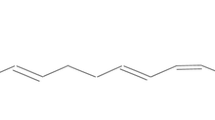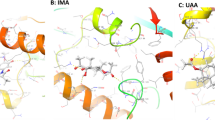Abstract
Glutathione S-transferases are major phase II detoxification enzymes. Taenia solium, a parasite of humans and pigs, is exposed to toxic products. The aim of this work was to purify and characterize a T. solium glutathione S-transferase isoform of 26.5 kDa (SGST26.5) in order to obtain its kinetic parameters. Homogeneous SGST26.5 was obtained by a simple purification procedure. SGST26.5 showed a pI of 7.07, and a native M r of 60 kDa with 26.5 kDa subunits. The optimum activity for SGST26.5 was found at pH 6.5–7.0 in the range 10–42°C. SGST26.5 had a specific enzyme activity of 78, 7.1, 6.6, and 0.7 μM min−1 mg−1 with CDNB, 1,2-dichloro-4-nitrobenzene, 2,4-hexadienal and trans-2-nonenal as substrates, respectively. It also had a k cat/K m(CDNB)=2.15×103 M−1 s−1, k cat/K m(GSH)=4.5×103 M−1 s−1 and V max for GSH and CDNB=74 and 77 μM min−1 mg−1, respectively. SGST26.5 was inhibited in a noncompetitive form by cibacron blue, bromosulfophthalein and triphenyltin chloride. Inhibition studies as a function of inhibitor concentration show that the enzyme is a homodimer. Bireactant system analysis show that it follows an ordered sequential mechanism.





Similar content being viewed by others
References
Albassam BA (1998) Inhibition of wheat leaves nitrate reductase activity by cibacron blue. Biochem Mol Biol Int 46: 979–986
Armstrong RN (1997) Structure, catalytic mechanism, and evolution of the glutathione transferases. Chem Res Toxicol 10:2–18
Baars AJ, Jansen M, Breimer D (1979) Xenobiotic metabolizing enzymes in Drosophila melanogaster. Activities of epoxide hydratasa and glutathione S-transferase compared with similar activities in rat liver. Mutat Res 62:279–291
Brophy PM, Barret J (1990a) Strategies for detoxification of aldehydic products of lipid peroxidation in helminthes. Mol Biochem Parasitol 42:205–212
Brophy PM, Barret J (1990b) Glutathione transferase in helminthes. Parasitology 100:345–349
Brophy PM, Barret J (1990c) Blocking factors and the isolation of glutathione transferase from Hymenolepis diminuta (Cestoda: Cyclophylidea). Parasitology 100:137–141
Brophy PM, Pritchard DI (1994) Parasitic helminth glutathione S-transferases: an update on their potential as targets for immuno- and chemotherapy. 79:89–96
Brophy PM, Southan C, Barret J (1989) Glutathione transferases in the tapeworm Moniezia expansa. Biochem J 262:939–946
Caccuri AM, Antonini G, Board P, Flanagan J, Parker MW, Paolesse R, Turella P, Federic G, Lo Bello M, Ricci G (2001) Human glutathione transferase T2-2 discloses some evolutionary strategies for optimization of substrate binding to the active site of glutathione transferases. J Biol Chem 276: 5427–5431
Clark AG (1989) The comparative enzymology of the glutathione S-transferases from non-vertebrate organisms. Comp Biochem Physiol 92B: 419–446
Cochrane BJ, Morrissey JJ, LeBlanc GA (1987) The genetics of xenobiotic metabolism in Drosophila. IV. Purification and characterization of the major glutathione S-transferase. Insect Biochem 17:731–738
Dierickx PJ (1987) Soluble glutathione S-transferase isoenzymes in Daphnia magna strains and their interactions with 2,4-dichlorophenoxy acetic acid and 1,4-benzoquinone. Insect Biochem 17:1–6
Dixon HBF, Lipscomb FM (1961) Cysticercosis: an analysis and follow up 450 cases. Privy Council Med Res Spec Rep Ser Lond 229:1–58
Frear DS, Swanson HR (1970) Biosynthesis of S-(4-ethylamino-6-isopropylamino-2-s-triazino) glutathione S-transferase from corn. Phytochemistry 9:2123–2132
Gonzalez R, Mendoza-Hernandez G, Plancarte A (2002) Purification of Taenia solium cysticerci superoxide dismutase and myoglobin copurification. Parasitol Res 88:881–887
Habig W H, Jakoby W (1981) Assays for differentiation of glutathione S-transferase. Methods Enzymol 77:398–405
Habig WH, Pabst MJ, Jakoby WB (1974) Glutathione S-transferase. The first enzymatic step in mercapturic acid formation. J Biol Chem 249:7130–7139
Jakoby WB (1976) The glutathione S-transferase: a triple-threat in detoxication, In: De Serres FJR, Bend JR, Philpot RM (eds) In vitro metabolic activation in mutagenesis testing. Elsevier/North-Holland Biomedical, Amsterdam, p 207
Ketter B, Coles B, Meyer DJ (1983) The role of glutathione in detoxication. Environ Health Perspect 49:59–69
Laemmli V (1970) Cleavage of structural proteins during the assembly of the head of bacteriophage T4. Nature 227:680–685
Lowry O, Rosenbrough N, Lewis-Farr A, Randall R (1951) Protein measurement with the Folin phenol reagent. J Biol Chem 193:265–275
Mannervik B (1985) The isoenzymes of glutathione transferase Adv Enzymol Relat Areas Mol Biol 57:357–417
Mannervik B (1988) Glutathione transferases-structure and catalytic activity. CRC Crit Rev Biochem 23:283–337
Mannervik B, Alin P, Guthenberg C, Jensson H, Tahir MK, Jornvall H (1985) Identification of three classes of cytosolic glutathione transferase common to several mammalian species: correlation between structural data and enzymic properties. Proc Natl Acad Sci U S A 82:7202
O’Leary KA, Hathaway KM, Tracy JW (1992) Schistosoma mansoni: single step purification and characterization of glutathione S-transferase isoenzyme 4. Exp Parasitol 75:47–55
Paglia, DE, Valentine WN (1967) Studies on the quantitative and qualitative characterization of erythrocyte glutathione peroxidase. J Lab Clin Med 70:158–169
Segel I (1975) Enzyme kinetics. Behavior and analysis of rapid equilibrium and steady-state enzyme systems. Wiley, New York, pp 100–160
Sheehan D, Meade G, Foley, VM, Dowd CA (2001) Structure, function and evolution of glutathione transferases: implications for classification of non-mammalian members of an ancient enzyme superfamily. Biochem J 360:1–16
Sjostrom M, Jakobsson P, Heimburger, M, Palmblad J, Haeggstrom J (2001) Human umbilical vein endothelial cells generate leukotriene C4 via microsomal glutathione S-transferase type 2 and express the CysLT1 receptor. Eur J Biochem 268:2578–2586
Tahir MK, Mannervik B (1985) Inhibitors for distinction of three types of human glutathione transferase. FEBS 181:249–252
Tahir MK, Mannervik B (1986) Simple inhibition studies for distinction between homodimeric and heterodimeric isoenzymes of glutathione transferase. J Biol Chem 261:1048–1051
Thomas ML, Rodees DG (1990) Determination of size, molecular weight, and presence of subunits. Methods Enzymol 182:566–587
Vibanco-Pérez N, Jiménez L, Merchant MT, Landa A (1999) Characterization of glutathione S-transferase of Taenia solium. J Parasitol 85: 448–453
Vibanco-Perez N, Jiménez L, Mendoza-Hernandez G, Landa A (2002) Characterization of a recombinant mu-class glutathione S-transferase from Taenia solium. Parasitol Res 88:398–404
White AC (1997) Neurocysticercosis: a major cause of neurological disease worldwide. Clin Infect Dis 24:101–113
Acknowledgements
This work was financed by the Consejo Nacional de Ciencia y Tecnología, México (Conacyt 27556-M) and Dirección General de Asuntos del Personal Académico, México) DGAPA IN212600. The authors wish to thank Dr. Gerardo Medina for valuable English corrections.
Author information
Authors and Affiliations
Corresponding author
Rights and permissions
About this article
Cite this article
Plancarte, A., Rendon, J.L. & Landa, A. Purification, characterization and kinetic properties of the Taenia solium glutathione S-transferase isoform 26.5 kDa. Parasitol Res 93, 137–144 (2004). https://doi.org/10.1007/s00436-004-1103-y
Received:
Accepted:
Published:
Issue Date:
DOI: https://doi.org/10.1007/s00436-004-1103-y




